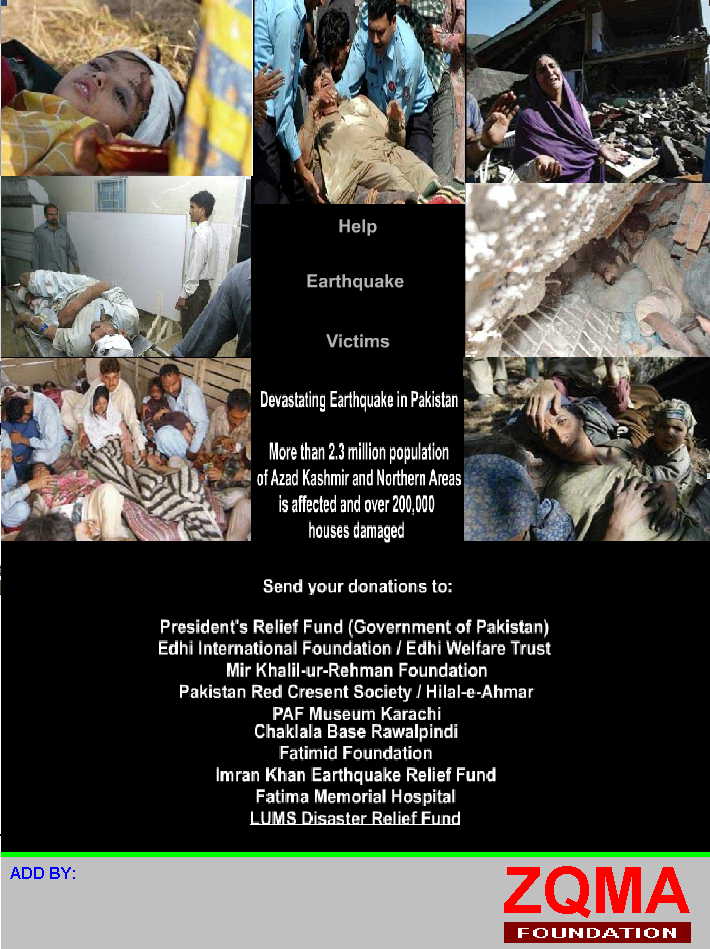| EARTHQUAKE HISTORY
Earthquake activity in Pakistan is mainly concentrated in the north and western sections of the country, along the boundary of the Indian plate and the Iranian and Afghan micro-plates. The Chaman Fault runs along Pakistan's western frontier with Afghanistan from Kalat, in the northern Makran range, past Quetta and then on to Kabul, Afghanistan. A fault also runs along the Makran coast and is believed to be of the same nature as the West Coast fault along the coast of Maharashtra, India. An active subduction zone exists off the Makran coast. The great 1945 earthquake was centred in this region. This zone forms the boundary between the Arabian and the Iranian micro-plate, where the former subducts or dives beneath the latter. Thrust zones run along the Kirthar, Sulaiman and Salt ranges. There are four faults in and around Karachi and other parts of deltaic Indus, and Makran coast. The first is the Allah Bund fault that passes through Shahbundar, Jah, Pakistan Steel Mills, and runs through eastern parts of the city and ends near Cape Monz. This fault, in fact, has caused extensive damage in the past many centuries in the deltaic areas. The destruction of Bhanbhor in the 13th century and damage to Shahbundar in 1896 were caused by this fault. The other one emanates from the Rann of Kutchh. The third one is the Pubb fault which ends into Arabian sea near Makran coast and the last one is located in the lower Dadu district near Surajani and falls in the vicinity of Karachi. Tsunamis or tidal waves have also affected the coast of Pakistan. The worst case was in 1945 when an earthquake of magnitude 7.9 struck the Makran coast, waves as high as 12 meters were reported.
HAZARD ZONATION
According to a map created by the Pakistan Met. Department, the country is divided into 4 zones based on expected ground acceleration. The areas surrounding Quetta, along the Makran coast and parts of the NWFP, along the Afghan border fall in Zone 4. The rest of the NWFP lies in Zone 3, with the exception of southern parts of this province which lie in Zone 2. The remaining parts of the Pakistani coast till Karachi also lie in Zone 3. The remaining parts of the country lie in Zone 2. The major cities of Peshawar, Rawalpindi and Islamabad both sit in this zone. But despite this, they are regularly rattled by strong earthquakes from the north or from neighbouring Afghanistan. The upper westernmost part of Balochistan and regions along the border with India lie in Zone 1. This zone also includes Lahore where there was serious damage caused by the 1905 Kangra earthquake in neighbouring India.
According to the GSHAP, the most vulnerable parts of Pakistan are parts of Balochstan province in and around Quetta stretching to the Afghan border and western parts of Balochistan, which include the Makran coast till the Iranian border. These regions could expect to have a maximum peak ground acceleration (PGA) ranging between 0.24g to 0.4g. Parts of northern Punjab could expect a maximum PGA ranging between 0.24g to 0.32g. Similar values of PGA could be expected in northern sections of the North-West Frontier Province (N.W.F.P.) and around Karachi, in Sindh Province. Maximum PGA values for the rest of the country do not fall below 0.8g. These values steadily decrease towards the Indian border. The region with the lowest maximum PGA is a region between Khangarh and Fort Abbas, along the international border with India. |

